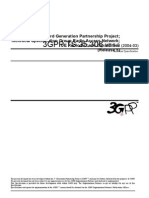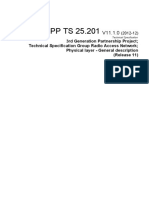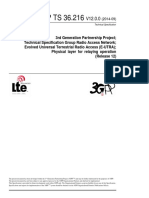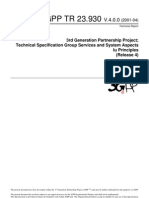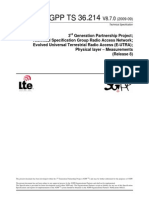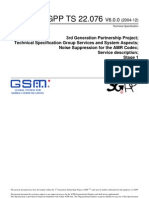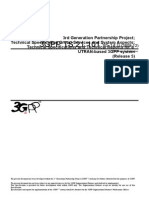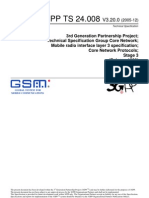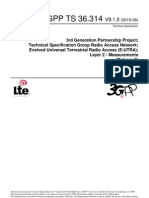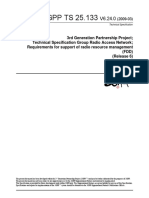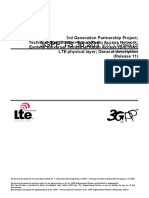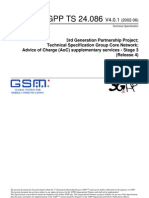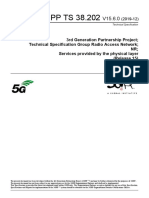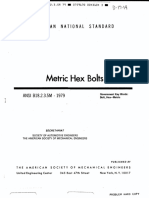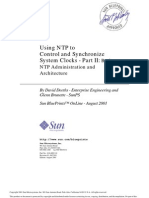3GPP TS 25.201
3GPP TS 25.201
Uploaded by
Rabindra Nath MandalCopyright:
Available Formats
3GPP TS 25.201
3GPP TS 25.201
Uploaded by
Rabindra Nath MandalOriginal Title
Copyright
Available Formats
Share this document
Did you find this document useful?
Is this content inappropriate?
Copyright:
Available Formats
3GPP TS 25.201
3GPP TS 25.201
Uploaded by
Rabindra Nath MandalCopyright:
Available Formats
3GPP TS 25.201 V3.4.
0 (2002-06)
Technical Specification
3rd Generation Partnership Project; Technical Specification Group Radio Access Network; Physical layer - General description (Release 1999)
The present document has been developed within the 3rd Generation Partnership Project (3GPP TM) and may be further elaborated for the purposes of 3GPP. The present document has not been subject to any approval process by the 3GPP Organisational Partners and shall not be implemented. This Specification is provided for future development work within 3GPP only. The Organisational Partners accept no liability for any use of this Specification. Specifications and reports for implementation of the 3GPP TM system should be obtained via the 3GPP Organisational Partners' Publications Offices.
Release 1999
3GPP TS 25.201 V3.4.0 (2002-06)
Keywords
UMTS, radio, layer 1
3GPP Postal address 3GPP support office address
650 Route des Lucioles - Sophia Antipolis Valbonne - FRANCE Tel.: +33 4 92 94 42 00 Fax: +33 4 93 65 47 16
Internet
http://www.3gpp.org
Copyright Notification No part may be reproduced except as authorized by written permission. The copyright and the foregoing restriction extend to reproduction in all media.
2002, 3GPP Organizational Partners (ARIB, CWTS, ETSI, T1, TTA, TTC). All rights reserved.
3GPP
Release 1999
3GPP TS 25.201 V3.4.0 (2002-06)
Contents
Contents....................................................................................................................................................3 Foreword...................................................................................................................................................4 1 Scope......................................................................................................................................................5 2 References..............................................................................................................................................5 3 Abbreviations.........................................................................................................................................6 4 General description of Layer 1...............................................................................................................6
4.1 Relation to other layers..........................................................................................................................................6 4.1.1 General Protocol Architecture.............................................................................................................................6 4.1.2 Service provided to higher layers........................................................................................................................7 4.2 General description of Layer 1...............................................................................................................................8 4.2.1 Multiple Access...................................................................................................................................................8 4.2.2 Channel coding and interleaving.........................................................................................................................8 4.2.3 Modulation and spreading...................................................................................................................................8 4.2.4 Physical layer procedures....................................................................................................................................9 4.2.5 Physical layer measurements..............................................................................................................................9 4.2.6 Relationship of the physical layer functions.......................................................................................................9
5 Document structure of physical layer specification..............................................................................10
5.1 Overview..............................................................................................................................................................10 5.2 TS 25.201: Physical layer General description.................................................................................................10 5.3 TS 25.211: Physical channels and mapping of transport channels onto physical channels (FDD).....................10 5.4 TS 25.212: Multiplexing and channel coding (FDD)..........................................................................................10 5.5 TS 25.213: Spreading and modulation (FDD).....................................................................................................11 5.6 TS 25.214: Physical layer procedures (FDD)......................................................................................................11 5.7 TS 25.215: Physical layer Measurements (FDD).............................................................................................11 5.8 TS 25.221: Physical channels and mapping of transport channels onto physical channels (TDD).....................11 5.9 TS 25.222: Multiplexing and channel coding (TDD)..........................................................................................12 5.10 TS 25.223: Spreading and modulation (TDD)...................................................................................................12 5.11 TS 25.224: Physical layer procedures (TDD)....................................................................................................12 5.12 TS 25.225: Physical layer Measurements (TDD)...........................................................................................12 5.13 TR 25.833: Physical layer items not for inclusion in Release 99.....................................................................12 5.14 TR 25.944: Channel coding and multiplexing examples...................................................................................13
Annex A (informative): Preferred mathematical notations.......................................................14 Annex B (informative): Change history......................................................................................15
3GPP
Release 1999
3GPP TS 25.201 V3.4.0 (2002-06)
Foreword
This Technical Specification (TS) has been produced by the 3rd Generation Partnership Project (3GPP). The contents of the present document are subject to continuing work within the TSG and may change following formal TSG approval. Should the TSG modify the contents of the present document, it will be re-released by the TSG with an identifying change of release date and an increase in version number as follows: Version x.y.z where: x the first digit: 1 presented to TSG for information; 2 presented to TSG for approval; 3 or greater indicates TSG approved document under change control. y the second digit is incremented for all changes of substance, i.e. technical enhancements, corrections, updates, etc. z the third digit is incremented when editorial only changes have been incorporated in the document.
3GPP
Release 1999
3GPP TS 25.201 V3.4.0 (2002-06)
1 Scope
The present document describes a general description of the physical layer of the UTRA radio interface. The present document also describes the document structure of the 3GPP physical layer specifications, i.e. TS 25.200 series. The TS 25.200 series specifies the Uu point for the 3G mobile system, and defines the minimum level of specifications required for basic connections in terms of mutual connectivity and compatibility.
2 References
The following documents contain provisions which, through reference in this text, constitute provisions of the present document. References are either specific (identified by date of publication, edition number, version number, etc.) or non-specific. For a specific reference, subsequent revisions do not apply. For a non-specific reference, the latest version applies. [1] [2] [3] [4] [5] [6] [7] [8] [9] [10] [11] [12] [13] [14] [15] [16] [17] [18] 3G TS 25.211: "Physical channels and mapping of transport channels onto physical channels (FDD)". 3G TS 25.212: "Multiplexing and channel coding (FDD)". 3G TS 25.213: "Spreading and modulation (FDD)". 3G TS 25.214: "Physical layer procedures (FDD)". 3G TS 25.215: "Physical layer Measurements (FDD)". 3G TS 25.221: "Physical channels and mapping of transport channels onto physical channels (TDD)". 3G TS 25.222: "Multiplexing and channel coding (TDD)". 3G TS 25.223: "Spreading and modulation (TDD)". 3G TS 25.224: "Physical layer procedures (TDD)". 3G TS 25.225: "Physical layer Measurements (TDD)". 3G TR 25.833: "Physical layer items not for inclusion in Release 99". 3G TR 25.944: "Channel coding and multiplexing examples". 3G TS 25.301: "Radio Interface Protocol Architecture". 3G TS 25.302: "Services provided by the physical layer". 3G TS 25.101: "UE Radio transmission and reception (FDD)". 3G TS 25.102: "UE Radio transmission and reception (TDD)". 3G TS 25.104: "BTS Radio transmission and reception (FDD)". 3G TS 25.105: "BTS Radio transmission and reception (TDD)".
3GPP
Release 1999
3GPP TS 25.201 V3.4.0 (2002-06)
3 Abbreviations
For the purposes of the present document, the following abbreviations apply: ARQ BER CCTrCH CPCH DCA DCH
DS-CDMA
Automatic Repeat Request Bit Error Rate Coded Composite Transport Channel Common Packet Channel Dynamic channel allocation Dedicated Channel
Direct-Sequence Code Division Multiple Access
DSCH FAUSCH FDD FEC FER GSM L1 L2 L3 LAC MAC Mcps ODMA QPSK RACH RF RLC RRC SAP SCCC SCH SIR TDD TDMA TFCI UE UMTS UTRA UTRAN WCDMA
Downlink Shared Channel Fast Uplink Signalling Channel Frequency Division Duplex Forward Error Correction Frame Error Rate Global System for Mobile Communication Layer 1 (physical layer) Layer 2 (data link layer) Layer 3 (network layer) Link Access Control Medium Access Control Mega Chip Per Second Opportunity Driven Multiple Access Quaternary Phase Shift Keying Random Access Channel Radio Frequency Radio Link Control Radio Resource Control Service Access Point Serial Concatenated Convolutional Code Synchronisation Channel Signal-to-Interference Ratio Time Division Duplex Time Division Multiple Access Transport-Format Combination Indicator User Equipment Universal Mobile Telecommunications System UMTS Terrestrial Radio Access UMTS Terrestrial Radio Access Network Wide-band Code Division Multiple Access
4 General description of Layer 1
4.1 Relation to other layers
4.1.1 General Protocol Architecture
Radio interface which is prescribed by this specification means the Uu point between User Equipment (UE) and network. The radio interface is composed of Layers 1, 2 and 3. Layer 1 is based on WCDMA technology and the TS 25.200 series describes the Layer-1 specification. Layers 2 and 3 of the radio interface are described in the TS 25.300 and 25.400 series, respectively.
3GPP
Release 1999
3GPP TS 25.201 V3.4.0 (2002-06)
Layer 3 Control / Measurements
Radio Resource Control (RRC)
Logical channels Medium (MAC) Access Control Transport channels
Layer 2
Layer 1
Physical layer
Figure 1: Radio interface protocol architecture around the physical layer Figure 1 shows the UTRA radio interface protocol architecture around the physical layer (Layer 1). The physical layer interfaces the Medium Access Control (MAC) sub-layer of Layer 2 and the Radio Resource Control (RRC) Layer of Layer 3. The circles between different layer/sub-layers indicate Service Access Points (SAPs). The physical layer offers different Transport channels to MAC. A transport channel is characterized by how the information is transferred over the radio interface. MAC offers different Logical channels to the Radio Link Control (RLC) sub-layer of Layer 2. A logical channel is characterized by the type of information transferred. Physical channels are defined in the physical layer. There are two duplex modes: Frequency Division Duplex (FDD) and Time Division Duplex (TDD). In the FDD mode a physical channel is characterized by the code, frequency and in the uplink the relative phase (I/Q). In the TDD mode the physical channels is also characterized by the timeslot. The physical layer is controlled by RRC.
4.1.2 Service provided to higher layers
The physical layer offers data transport services to higher layers. The access to these services is through the use of transport channels via the MAC sub-layer. The physical layer is expected to perform the following functions in order to provide the data transport service. See also TS 25.302: Macrodiversity distribution/combining and soft handover execution. Error detection on transport channels and indication to higher layers. FEC encoding/decoding of transport channels. Multiplexing of transport channels and demultiplexing of coded composite transport channels (CCTrCHs). Rate matching of coded transport channels to physical channels. Mapping of coded composite transport channels on physical channels. Power weighting and combining of physical channels. Modulation and spreading/demodulation and despreading of physical channels. Frequency and time (chip, bit, slot, frame) synchronisation. Radio characteristics measurements including FER, SIR, Interference Power, etc., and indication to higher layers. Inner - loop power control. RF processing. (Note: RF processing is defined in TS 25.100 series).
When network elements (UEs and network) provide compatible service bearers (for example support a speech bearer) they should be assured of successful interworking. Moreover, different implementation options of the same (optional) feature would lead to incompatibility between UE and network. Therefore, this shall be avoided.
3GPP
Release 1999
3GPP TS 25.201 V3.4.0 (2002-06)
4.2 General description of Layer 1
4.2.1 Multiple Access
The access scheme is Direct-Sequence Code Division Multiple Access (DS-CDMA) with information spread over approximately 5 MHz bandwidth, thus also often denoted as Wideband CDMA (WCDMA) due that nature. UTRA has two modes, FDD (Frequency Division Duplex) & TDD (Time Division Duplex), for operating with paired and unpaired bands respectively. The possibility to operate in either FDD or TDD mode allows for efficient utilisation of the available spectrum according to the frequency allocation in different regions. FDD and TDD modes are defined as follows: FDD: A duplex method whereby uplink and downlink transmissions use two separated radio frequencies. In the FDD, each uplink and downlink uses the different frequency band. A pair of frequency bands which have specified separation shall be assigned for the system. TDD: A duplex method whereby uplink and downlink transmissions are carried over same radio frequency by using synchronised time intervals. In the TDD, time slots in a physical channel are divided into transmission and reception part. Information on uplink and downlink are transmitted reciprocally. In UTRA TDD there is TDMA component in the multiple access in addition to DS-CDMA. Thus the multiple access has been also often denoted as TDMA/CDMA due added TDMA nature. A 10 ms radio frame is divided into 15 slots (2560 chip/slot at the chip rate 3.84 Mcps). A physical channel is therefore defined as a code (or number of codes) and additionally in TDD mode the sequence of time slots completes the definition of a physical channel. The information rate of the channel varies with the symbol rate being derived from the 3.84 Mcps chip rate and the spreading factor. Spreading factors are from 256 to 4 with FDD uplink, from 512 to 4 with FDD downlink, and from 16 to 1 for TDD uplink and downlink. Thus the respective modulation symbol rates vary from 960 k symbols/s to 15 k symbols/s (7.5 k symbols/s) for FDD uplink (downlink), and for TDD the momentary modulation symbol rates shall vary from 3.84 M symbols/s to 240 k symbols/s.
4.2.2 Channel coding and interleaving
For the channel coding in UTRA two options are supported for FDD and three options are supported for TDD: Convolutional coding. Turbo coding. No coding (TDD only).
Channel coding selection is indicated by higher layers. In order to randomise transmission errors, bit interleaving is performed further.
4.2.3 Modulation and spreading
The UTRA modulation scheme is QPSK. Pulse shaping is specified in the TS 25.100 series. With CDMA nature the spreading (& scrambling) process is closely associated with modulation. In UTRA different families of spreading codes are used to spread the signal: For separating channels from same source, channelisation codes derived with the code tree structure as given in TS 25.213 and 25.223 are used. For separating different cells the following solutions are supported. FDD mode: Gold codes with 10 ms period (38400 chips at 3.84 Mcps) used, with the actual code itself length 218-1 chips, as defined in TS 25.213. TDD mode: Scrambling codes with the length 16 used as defined in TS 25.223.
3GPP
Release 1999
3GPP TS 25.201 V3.4.0 (2002-06)
For separating different UEs the following code families are defined. FDD mode: Gold codes with 10 ms period, or alternatively S(2) codes 256 chip period. TDD mode: codes with period of 16 chips and midamble sequences of different length depending on the environment.
4.2.4 Physical layer procedures
There are several physical layer procedures involved with UTRA operation. Such procedures covered by physical layer description are: 1) The power control, inner loop for FDD mode, and for TDD mode open loop in uplink and inner loop in downlink. 2) Cell search operation.
4.2.5 Physical layer measurements
Radio characteristics including FER, SIR, Interference power, etc., are measured and reported to higher layers and network. Such measurements are: 1) Handover measurements for handover within UTRA. Specific features being determined in addition to the relative strength of the cell, for the FDD mode the timing relation between for cells for support of asynchronous soft handover. 2) The measurement procedures for preparation for handover to GSM900/GSM1800. 3) The measurement procedures for UE before random access process. 4) The measurement procedures for Dynamic Channel Allocation (DCA) of TDD mode.
4.2.6 Relationship of the physical layer functions
The functionality of the layer 1 is split over several specifications each for FDD and TDD. The following figures, although not categorical, show as an introduction the relationship of layer 1 functions by specification in terms of users plane information flow.
25.214 procedures
25.215 measurements
control
25.211
25.213
traffic
25.212
Figure 2 - FDD layer 1 functions relationships by specification
3GPP
Release 1999
10
3GPP TS 25.201 V3.4.0 (2002-06)
25.224 procedures
25.225 measurements
control
25.221
25.223
traffic
25.222
Figure 3 - TDD layer 1 functions relationships by specification
5 Document structure of physical layer specification
5.1 Overview
The physical layer specification consists of a general document (TS 25.201), five FDD mode documents (TS 25.211 through 25.215), five TDD mode documents (TS 25.221 through 25.225). In addition, there are two technical reports (TR 25.833 and 25.944).
5.2 TS 25.201: Physical layer General description
The scope is to describe: the contents of the Layer 1documents (TS 25.200 series); where to find information; a general description of Layer 1.
5.3 TS 25.211: Physical channels and mapping of transport channels onto physical channels (FDD)
The scope is to establish the characteristics of the Layer-1 transport channels and physical channels in the FDD mode, and to specify: the different transport channels that exist; which physical channels exist; what is the structure of each physical channel, slot format etc.; relative timing between different physical channels in the same link, and relative timing between uplink and downlink; mapping of transport channels onto the physical channels.
5.4 TS 25.212: Multiplexing and channel coding (FDD)
The scope is to describe multiplexing, channel coding and interleaving in the FDD mode, and to specify:
3GPP
Release 1999
11
3GPP TS 25.201 V3.4.0 (2002-06)
coding and multiplexing of transport channels into CCTrCHs; channel coding alternatives; coding for Layer 1 control information, such as TFCI; the different interleavers; how is rate matching done; physical channel segmentation and mapping.
5.5 TS 25.213: Spreading and modulation (FDD)
The scope is to establish the characteristics of the spreading and modulation in the FDD mode, and to specify: the spreading (channelisation plus scrambling); generation of channelisation and scrambling codes; generation of RACH and CPCH preamble codes; generation of SCH synchronisation codes; modulation.
RF channel arrangements and Pulse shaping are specified in TS 25.101 for UE and in TS 25.104 for Node-B.
5.6 TS 25.214: Physical layer procedures (FDD)
The scope is to establish the characteristics of the physical layer procedures in the FDD mode, and to specify: cell search procedures; power control procedures; random access procedure.
5.7 TS 25.215: Physical layer Measurements (FDD)
The scope is to establish the characteristics of the physical layer measurements in the FDD mode, and to specify: the measurements that Layer 1 is to perform; reporting of measurements to higher layers and network; handover measurements, idle-mode measurements etc.
5.8 TS 25.221: Physical channels and mapping of transport channels onto physical channels (TDD)
The scope is to establish the characteristics of the Layer-1 transport channels and physical channels in the TDD mode, and to specify: transport channels; physical channels, structure and contents; mapping of transport channels onto the physical channels.
3GPP
Release 1999
12
3GPP TS 25.201 V3.4.0 (2002-06)
5.9 TS 25.222: Multiplexing and channel coding (TDD)
The scope is to describe multiplexing, channel coding and interleaving in the TDD mode, and to specify: channel coding and multiplexing of transport channels into CCTrCHs; channel coding alternatives; coding for Layer 1 control information, such as TFCI; interleaving; rate matching; physical channel segmentation and mapping.
5.10 TS 25.223: Spreading and modulation (TDD)
The scope is to establish the characteristics of the spreading and modulation in the TDD mode, and to specify: data modulation; spreading; generation of synchronisation codes.
RF channel arrangements and Pulse shaping are specified in TS 25.102 for UE and in TS 25.105 for Node-B.
5.11 TS 25.224: Physical layer procedures (TDD)
The scope is to establish the characteristics of the physical layer procedures in the TDD mode, and to specify: cell synchronisation; timing advance; power control procedures; idle mode tasks.
5.12 TS 25.225: Physical layer Measurements (TDD)
The scope is to establish the characteristics of the physical layer measurements in the TDD mode, and to specify: the measurements that Layer 1 is to perform; reporting of measurements to higher layers and network; handover measurements, idle-mode measurements etc.
5.13 TR 25.833: Physical layer items not for inclusion in Release 99
The scope is to collect materials on UTRA physical layer items not included in the Release 99 specification documents, such as DSCH control channel, FAUSCH, Hybrid ARQ, 4-state SCCC turbo coding and ODMA.
3GPP
Release 1999
13
3GPP TS 25.201 V3.4.0 (2002-06)
5.14 TR 25.944: Channel coding and multiplexing examples
The scope is to describe examples of channel coding and multiplexing for transport channels of various types and cases.
3GPP
Release 1999
14
3GPP TS 25.201 V3.4.0 (2002-06)
Annex A (informative): Preferred mathematical notations
The following table contains the preferred mathematical notations used in L1 documentation.
item multiply product matrix product scalar product (product of a matrix by a scalar) matrix dimensioning Kronecker product bracketing of sets (all elements of same type, not ordered elements) bracketing of lists (all elements not necessary of same type, ordered elements) bracketing of sequences (all elements of same type, ordered elements) bracketing of function argument bracketing of array index bracketing of matrix or vector Separation of indexes use of italic for symbols bracketing of arithmetic expression to force precedence of operations necessity of bracketing arithmetic expressions number type binary xor and and matrix or vector transpose 1 1 matrices vector dot product complex conjugate matrix or vector Hermitian transpose real part and imaginary part of complex numbers. notation cross sign, e.g. a b dot sign, e.g. a b dot sign, scalar should precede matrix e.g.
(1 + j )
u v
number of rows number of column, e.g.: R C ab curly brackets {}, e.g. {a1, a2, ,ap}, or
{ ai } i{1, 2,, p}
ai
round brackets (), e.g. (A, u, x) angle brackets, e.g. <a1, a2, ,ap> or
i{1, 2 ,, p }
round brackets, e.g. f(x) square brackets, e.g. a[x] square brackets [], e.g.
x y , [ x
1 1 y ] , or 1 1
use a comma : e.g. Ni,j a symbol should be either in italic or in normal font, but mixing up should be avoided. round brackets : e.g.
( a + b) c
When only + and bracketing is not necessary. When the mod operator is used explicit bracketing of mod operands and possibly result should be done. in a context of non negative integer numbers, some notes should stress when a number is signed, or possibly fractional. respectively use + or . If no "mod 2" is explicitly in the expression some text should stress that the operation is modulo 2. vT implicitly cast to its unique element. uT v for column vectors, and u vT for line vectors v* vH Re(x) and Im(x)
3GPP
Release 1999
15
3GPP TS 25.201 V3.4.0 (2002-06)
Annex B (informative): Change history
Change history
Date 14/01/00 31/03/00 26/06/00 26/06/00 26/06/00 26/06/00 14/12/01 08/03/02 07/06/02 TSG # RAN_05 RAN_07 RAN_08 RAN_08 RAN_08 RAN_08 CR Rev Subject/Comment Approved at TSG RAN #5 and placed under Change Control Modified in terms of its formality. The contents were not changed. 001 - Editorial revision 002 - Corrections to align with TS 25.212 and TR 25.944 003 1 Editorial corrections 004 - Physical layer information flow 005 1 Preferred mathematical notation for editorial unity of L1 documentation RAN_14 RP-010735 007 - Removal of slow power control and ODMA from TS 25.201 RAN_15 RP-020231 009 2 Removal of channel coding option no coding for FDD RAN_16 RP-020306 015 - Downlink bit mapping TSG Doc. RP-99586 RP-000059 RP-000264 RP-000264 RP-000264 RP-000264 Old 3.0.0 3.0.1 3.0.2 3.0.2 3.0.2 3.0.2 3.1.0 3.2.0 3.3.0 New 3.0.0 3.0.1 3.0.2 3.1.0 3.1.0 3.1.0 3.1.0 3.2.0 3.3.0 3.4.0
3GPP
You might also like
- Fco Guerrero 110624Document7 pagesFco Guerrero 110624freyberarteaga2100% (1)
- FOE ReviewerDocument80 pagesFOE ReviewerNikko Tolentino100% (10)
- LTE and the Evolution to 4G Wireless: Design and Measurement ChallengesFrom EverandLTE and the Evolution to 4G Wireless: Design and Measurement ChallengesMoray RumneyRating: 5 out of 5 stars5/5 (1)
- TM 9-1375-213-34Document88 pagesTM 9-1375-213-34Heina GalvezNo ratings yet
- CWTS STD-DS-25.201Document15 pagesCWTS STD-DS-25.201rohitvanNo ratings yet
- 3GPP TS 25.306Document29 pages3GPP TS 25.306Chidhuro OwenNo ratings yet
- 25201-b10 Capa 1Document16 pages25201-b10 Capa 1Jose Vicente Melo CortésNo ratings yet
- 3GPP TS 25.306Document50 pages3GPP TS 25.306Johnny DoeNo ratings yet
- 36201-c20 4G LTE Physical Layer General DescriptionDocument15 pages36201-c20 4G LTE Physical Layer General DescriptionDuval FortesNo ratings yet
- 3rd Generation Partnership Project Technical Specification Group Core Network GSM - UMTS Public Land Mobile Natwork (PLMN) Access Reference Configuration (Release 1999)Document10 pages3rd Generation Partnership Project Technical Specification Group Core Network GSM - UMTS Public Land Mobile Natwork (PLMN) Access Reference Configuration (Release 1999)santanameroNo ratings yet
- Chanell ModelDocument25 pagesChanell ModelAssd TopNo ratings yet
- Evolved Universal Terrestrial Radio Access (E-UTRA) Physical Layer For Relaying OperationDocument16 pagesEvolved Universal Terrestrial Radio Access (E-UTRA) Physical Layer For Relaying OperationJennifer HaneyNo ratings yet
- 3GPP TS 22.094Document12 pages3GPP TS 22.094santanameroNo ratings yet
- 3GPP TR 25.944 V3.5.0 (2001-06)Document64 pages3GPP TR 25.944 V3.5.0 (2001-06)Hoài HàNo ratings yet
- 3GPP TS 22.096Document10 pages3GPP TS 22.096santanameroNo ratings yet
- 3G ChannelsDocument51 pages3G ChannelsKumar PalanisamyNo ratings yet
- 3GPP TS 24.085Document10 pages3GPP TS 24.085santanameroNo ratings yet
- 620 IuantDocument11 pages620 IuantABHILASHNo ratings yet
- 3GPP TR 23.919Document11 pages3GPP TR 23.919İsmail AkkaşNo ratings yet
- RP 030343Document59 pagesRP 030343AHTuGPbI3No ratings yet
- 3GPP TR 23.930Document11 pages3GPP TR 23.930santanameroNo ratings yet
- 36214-870 LteDocument12 pages36214-870 LtePunita SharmaNo ratings yet
- 3GPP TS 25.214Document88 pages3GPP TS 25.214gtspauldingNo ratings yet
- 3GPP TS 22.076Document10 pages3GPP TS 22.076santanameroNo ratings yet
- 3GPP TS 22.076Document10 pages3GPP TS 22.076santanameroNo ratings yet
- 3GPP TS 21.101Document15 pages3GPP TS 21.101EftalitNo ratings yet
- 3GPP TS 22.076Document10 pages3GPP TS 22.076santanameroNo ratings yet
- 3GPP TS 24.002Document11 pages3GPP TS 24.002santanameroNo ratings yet
- 3GPP TS 24.085Document10 pages3GPP TS 24.085santanameroNo ratings yet
- 3GPP TS 21.101Document16 pages3GPP TS 21.101santanameroNo ratings yet
- Search Results: 3GPP Specification: 25.211Document4 pagesSearch Results: 3GPP Specification: 25.211auto_knightNo ratings yet
- 340Document13 pages340Pavitra DayanidhiNo ratings yet
- 3rd Generation Partnership Project Technical Specification Group Services and System Aspects Name Identification Supplementary Services Stage 1 (3G TS 22.096 Version 3.0.1)Document11 pages3rd Generation Partnership Project Technical Specification Group Services and System Aspects Name Identification Supplementary Services Stage 1 (3G TS 22.096 Version 3.0.1)santanameroNo ratings yet
- 3GPP TS 24.085Document10 pages3GPP TS 24.085santanameroNo ratings yet
- Release 13 TR 21.905 V13.0.0 Vocabulary For 3GPP SpecificationsDocument65 pagesRelease 13 TR 21.905 V13.0.0 Vocabulary For 3GPP SpecificationsFlávia LarisseNo ratings yet
- 3GPP TS 21.101Document25 pages3GPP TS 21.101mohye123No ratings yet
- 3GPP TS 25.461Document9 pages3GPP TS 25.461holapaquitoNo ratings yet
- 660Document18 pages660santanameroNo ratings yet
- 25424-630-Iur DataDocument10 pages25424-630-Iur DataABHILASHNo ratings yet
- RP 040046Document181 pagesRP 040046Ruchira ChinthakaNo ratings yet
- 3GPP TS 22.002Document13 pages3GPP TS 22.002Ahmad Mustafa AtharNo ratings yet
- 3GPP TS 22.076Document10 pages3GPP TS 22.076santanameroNo ratings yet
- ARIB TR-T12-25.944 V3.5.0 Channel Coding and Multiplexing Examples (Release 1999)Document65 pagesARIB TR-T12-25.944 V3.5.0 Channel Coding and Multiplexing Examples (Release 1999)HarikrishnaChinthalaboyinaNo ratings yet
- 3GPP TS 24.002Document11 pages3GPP TS 24.002santanameroNo ratings yet
- GSMDocument450 pagesGSMSatyendranath YaminiNo ratings yet
- 3GPP TS 21.101Document17 pages3GPP TS 21.101santanameroNo ratings yet
- 3GPP TS 36.314Document17 pages3GPP TS 36.314Adela VladNo ratings yet
- 6o0 RRMDocument184 pages6o0 RRMABHILASHNo ratings yet
- 350 PDFDocument20 pages350 PDFJosephNo ratings yet
- 3GPP TS 22.002Document13 pages3GPP TS 22.002bhushan7408No ratings yet
- 21905-h10 - Vocabulary For 3GPP SpecificationsDocument65 pages21905-h10 - Vocabulary For 3GPP Specificationsbinayaks248No ratings yet
- 3GPP TS 36.201Document13 pages3GPP TS 36.201Kapil SinghNo ratings yet
- 300Document48 pages300santanameroNo ratings yet
- 3rd Generation Partnership Project Technical Specification Group Services and System Aspects Release 1999 Specifications (3G TS 21.101 Version 1.0.0)Document21 pages3rd Generation Partnership Project Technical Specification Group Services and System Aspects Release 1999 Specifications (3G TS 21.101 Version 1.0.0)santanameroNo ratings yet
- 3GPP TS 24.086Document11 pages3GPP TS 24.086santanameroNo ratings yet
- 620 IupcDocument12 pages620 IupcABHILASHNo ratings yet
- 3GPP TS 38.202Document14 pages3GPP TS 38.202jinNo ratings yet
- 3GPP TS 21.101Document21 pages3GPP TS 21.101santanameroNo ratings yet
- 3GPP TS 38.522Document17 pages3GPP TS 38.522AhmedMa'moonNo ratings yet
- 3rd Generation Partnership Project Technical Specification Group Services and System Aspects Service Accessibility (Release 1999)Document14 pages3rd Generation Partnership Project Technical Specification Group Services and System Aspects Service Accessibility (Release 1999)santanameroNo ratings yet
- Broadband Wireless Mobile: 3G and BeyondFrom EverandBroadband Wireless Mobile: 3G and BeyondWillie W. LuNo ratings yet
- Single Carrier FDMA: A New Air Interface for Long Term EvolutionFrom EverandSingle Carrier FDMA: A New Air Interface for Long Term EvolutionNo ratings yet
- True GDM 33CPT 54 MerchandiserDocument2 pagesTrue GDM 33CPT 54 Merchandiserwsfc-ebayNo ratings yet
- ITC571 - Emerging Technologies and Innovation - Assessment Item 4Document7 pagesITC571 - Emerging Technologies and Innovation - Assessment Item 4G.Prabhaharan GowthamNo ratings yet
- Fundamentals On The Subject of PipingDocument21 pagesFundamentals On The Subject of PipingRienheart GabornoNo ratings yet
- A While Loop Statement in C Programming Language Repeatedly Executes A Target Statement As Long As A Given Condition Is TrueDocument16 pagesA While Loop Statement in C Programming Language Repeatedly Executes A Target Statement As Long As A Given Condition Is TrueMd Sakawat HossainNo ratings yet
- Rolltor 4020 GBDocument2 pagesRolltor 4020 GBKristaps PuļķisNo ratings yet
- I Professionalism Syllabus Reading Material NPPEDocument4 pagesI Professionalism Syllabus Reading Material NPPESantiago GarcíaNo ratings yet
- Proposed Rule: Medicare: Electronic Prescription Drug Program E-PrescribingDocument20 pagesProposed Rule: Medicare: Electronic Prescription Drug Program E-PrescribingJustia.comNo ratings yet
- Reamer Running and Drillout Protocol Wft005188Document1 pageReamer Running and Drillout Protocol Wft005188mbhadelNo ratings yet
- PM Debug InfoDocument226 pagesPM Debug InfoMily Del RosarioNo ratings yet
- Boq For Road WorksDocument6 pagesBoq For Road WorksFaisal KhanNo ratings yet
- Iec60068-2-78 Ed2Document18 pagesIec60068-2-78 Ed2dlm_aqp5304No ratings yet
- AI Governance For The EnterpriseDocument20 pagesAI Governance For The EnterpriseabhishekraojanagamNo ratings yet
- OctoboxDocument11 pagesOctoboxSatadal GuptaNo ratings yet
- NIOS 5.1r5-5 GA ReleaseNotesDocument21 pagesNIOS 5.1r5-5 GA ReleaseNotesRicardo E. SantoNo ratings yet
- Yeastar S Series Administrator Guide enDocument123 pagesYeastar S Series Administrator Guide enChavara Matekwe100% (1)
- Dpe WapdaDocument2 pagesDpe WapdaZulKafil100% (1)
- Site Quality Acceptance Certificate: NoteDocument1 pageSite Quality Acceptance Certificate: NotewesleyNo ratings yet
- x.25 CookbookDocument332 pagesx.25 CookbookFahad ShahNo ratings yet
- "Rectbeam" - Rectangular Concrete Beam Analysis/Design: Program DescriptionDocument24 pages"Rectbeam" - Rectangular Concrete Beam Analysis/Design: Program DescriptionWaqas AnjumNo ratings yet
- CME 694 494 F2020 SyllabusDocument5 pagesCME 694 494 F2020 SyllabusraatornNo ratings yet
- Foam Top Pourer Set Mk5: Key FeaturesDocument4 pagesFoam Top Pourer Set Mk5: Key FeaturesFlo RenceNo ratings yet
- Structure of A WAC Report Ftmba Trim IiiDocument4 pagesStructure of A WAC Report Ftmba Trim IiiJavedNo ratings yet
- European Conductor Stranding: Acc. To VDE 0295, IEC 60228, EN 60228Document2 pagesEuropean Conductor Stranding: Acc. To VDE 0295, IEC 60228, EN 60228AdrianNo ratings yet
- ANSI B18.2.3.5M-1979 Metric Hex BoltDocument18 pagesANSI B18.2.3.5M-1979 Metric Hex BoltBambang Setiyo Adji PamungkasNo ratings yet
- ICEpdf Developers GuideDocument54 pagesICEpdf Developers Guidecarlos_besil0% (2)
- FR 2009 CatalogueDocument32 pagesFR 2009 CatalogueAnca SuciuNo ratings yet
- Sun Blueprints (816-0092) - Using NTP To Control and Synchronize System Clocks - Part II, Basic NTP AdminDocument23 pagesSun Blueprints (816-0092) - Using NTP To Control and Synchronize System Clocks - Part II, Basic NTP Admina_rojas_m2912No ratings yet





